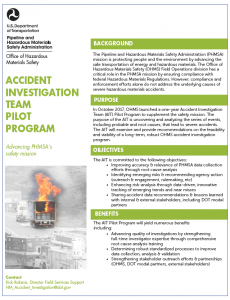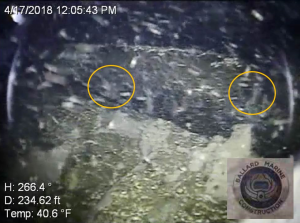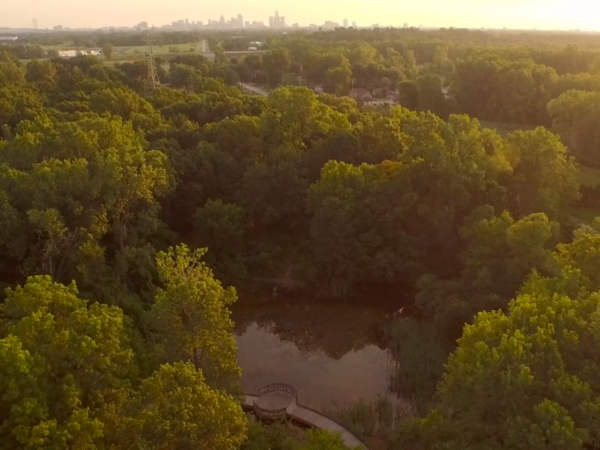
One month after American Transmission Company (ATC) reported damage to its powerlines which caused an estimated 600-gallon chemical leak in the Straits of Mackinac, the federal Pipeline and Hazardous Materials Safety Administration (PHMSA) has asked that Enbridge lower the maximum operating pressure along Line 5 – which rests on the lakebed near ATC lines – until repairs can be made along the pipeline.
Line 5 carries 23 million gallons of oil and natural gas liquids along two 4.5 mile-long pipelines underneath the Straits of Mackinac between the Lower and Upper Peninsula.
When ATC reported the damage to its powerlines that carry electricity from Michigan’s Lower to Upper Peninsula, Enbridge decided to inspect its own pipelines 12 yards east of the ATC powerlines and discovered three dents, (see photos) but said there was no structural damage and no leaks reported of oil or natural gas. However, at the time the dents were discovered – on or around April 10th – Enbridge did not lower the pressure along its lines.
Michigan Attorney General Bill Schuette has filed a civil suit against Van Enkevort Tug and Barge, Inc., saying the company’s ship dragged an anchor across the Straits of Mackinac causing damage to the ATC lines as well as to Line 5. The suit was filed in Ingham County Circuit Court on April 19th. Schuette’s office says investigators from the Department of Environmental Quaility, Department of Natural Resources, and the Department of Attorney General were able to determine the Van Enkevort-owned ship was passing through the Straits at the time the damage was caused to the ATC Cables and Enbridge Line 5 pipelines.
Darius Kirkwood at PHMSA’s Office of Governmental, International and Public Affairs released this statement to Great Lakes Now, “ Enbridge has implemented a voluntary pressure restriction at the location of the dents until they can be further evaluated. PHMSA continues to monitor Enbridge’s activities and assessment of the impact locations.”
Enbridge spokesperson Ryan Duffy tells Great Lakes Now, “This week, Enbridge placed additional operating pressure restrictions on the pipelines across the Straits of Mackinac as a precautionary and prudent measure. We took this step in close consultation with our federal regulator PHMSA, with federal code, and with the State of Michigan.”
Duffy says, “Diver inspections continue. Plans to reinforce the pipes continue to be developed and will be finalized in close coordination with PHMSA and the State of Michigan. The structural integrity of the pipes remain sound and the regular operations of the pipelines continue at the reduced pressure limit.
We continue to work closely with the State and United States Coast Guard as they investigate the incident. “
Great Lakes Now asked Michigan Department of Environmental Quality’s Scott Dean to explain the State of Michigan’s role in the latest precautionary measures along Line 5. Dean says, “State officials remain in close contact with Enbridge Energy regarding the status of the dual Line 5 pipelines in the Straits. Tests conducted by Enbridge and reviewed by the state have shown that Line 5 continues to operate without leaks.”
Dean tells Great Lakes Now it was the latest discovery of new evidence of damage that prompted the request to lower pressure along Line 5. He says, “On April 25 divers inspecting the twin lines where dents from vessel activity had previously been photographed by a remotely operated vehicle observed marring on the surface of the pipelines at those locations. As a result of those observations, Enbridge is developing plans to repair and reinforce the pipelines at those locations. In addition, the federal Pipeline and Hazardous Materials Safety Administration has asked that Enbridge lower the maximum operating pressure of Line 5 at the Straits until the immediate repair condition has been addressed and Enbridge has complied with this request.”
Dean says, “State agencies fully support this action as a critical precautionary step. The agencies continue to have regular contact with Enbridge to ensure the company’s compliance with its agreement with the State of Michigan and its due diligence regarding this recent incident.”

Mike Shriberg, Great Lakes regional executive director of the National Wildlife Federation, courtesy of nwf.org
Great Lakes executive director of the National Wildlife Federation and a member of Michigan’s Pipeline Safety Advisory Board Mike Shriberg says lowering pressure along Enbridge’s 65 year old pipeline in the Straits of Mackinac isn’t enough.
Shriberg tells Great Lakes Now, “All flow into Line 5 should be stopped immediately to protect the Great Lakes from imminent danger of an oil pipeline rupture until and unless independent analyses show that the pipeline is safe. If Line 5 is so damaged that an emergency flow restriction is necessary, then it is too unsafe to continue to operate in the Straits of Mackinac and risk the water, wildlife and economy of the Great Lakes. This should be the beginning of the permanent decommissioning of Line 5 in the Straits.”
Shortly after the dents were discovered along Line 5 in early April, Michigan Governor Rick Snyder urged Enbridge to find new ways to avoid anchor-strike damage and said Enbridge should speed up the search for alternatives to the pipeline.
(Editor’s Note: For more on Line 5, watch our documentary “Beneath the Surface: The Line 5 Pipeline in the Great Lakes“)
1 Comment
-
On this….
>>>>>”All flow into Line 5 should be stopped immediately to protect the Great Lakes from imminent danger of an oil pipeline rupture until and unless independent analyses show that the pipeline is safe.”
This is an example of a non-engineering/non-science-based statement by the National Wildlife Federation. Note that NWF last Friday released a statement with the false claim that PHMSA had enacted a “flow restriction” on Line 5…..a claim that was fabricated out of nothing by NWF and widely published by NWF without any verification or backing by PHMSA.
Now NWF is making that claim that an imminent risk exists from the small dents caused by the anchor strikes without having any basis at all for making such a statement, and then they insist that an independent assessment of the situation is needed without acknowledging that such an assessment is exactly what PHMSA is providing.
The Mackinac Straits Line 5 segments typically operate far below their maximum rated pressure of 600 PSI, typically in the range of 150-200 PSI. They will have peaks during startups and shutdowns that go higher, but the restriction imposed is to reduce the 600 PSI maximum pressure, according to press reports on PHMSA’s position.






